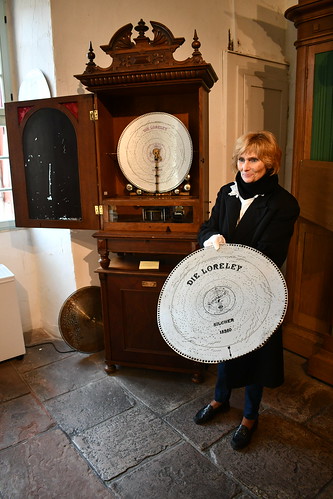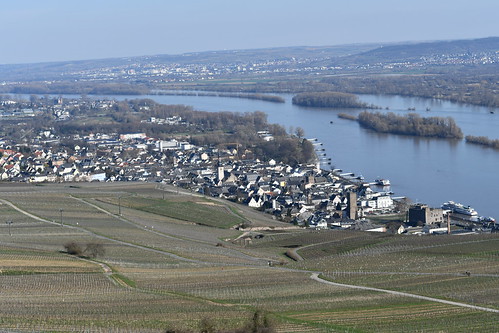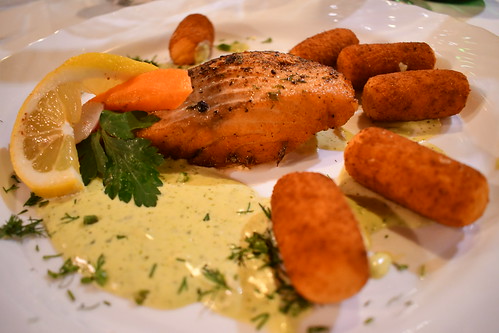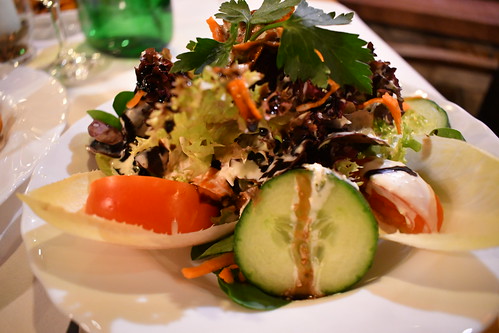History Comes Alive in Rüdesheim am Rhein
Like many international travelers, I have landed in Frankfurt on my way to another destination and then departed a short time later. Until recently, I never considered exploring the city or any nearby destinations. After seeing history come alive in Frankfurt, we drove into the countryside to Rüdesheim am Rhein in the Upper Middle Rhine Valley. In 2002, this region was added to the UNESCO list of World Heritage Sites.

Boosenburg Castle
Most visitors stop for part of day in Rüdesheim am Rhein when they are taking river cruises promoting medieval castles and wine tasting. Wine mavens come for the Riesling and Spätburgunder (pinot noir). This region is considered the best place in the world for these two varieties. While we did indulge in wine tasting, our private guide Herr Zahn catered our tour to our interest in Rüdesheim’s historical sites.
With less than 24 hours in town, it was impractical to seek out medieval castles along the river or take an extended hike. Instead, we used old-fashioned foot power to sample some of Rüdesheim’s noteworthy sites.
Walking Tour
Herr Zahn met us at the Central Hotel, a family-owned boutique hotel with renovated and spacious rooms located in the historic district. As we strolled on cobblestone narrow streets neatly sandwiched between the river and the steep terraced slopes consumed by vineyards, Herr Zahn pointed out half-timbered houses and an assortment of buildings dating back centuries. Most notable was the Klunkhardshof.

Klunkhardshof
Our route took us to Drosselgasse, a narrow historic lane filled with restaurants, bars, and wine gardens.

Drosselgasse
We stopped to read a commemorative plaque recalling a World War II bombing that destroyed a small section of the city, and a smaller sign showed the site of the Synagogue of the Israeli Religious Community of Rüdesheim-Geisenhiem that was founded in 1843. Like so many other Jewish communities throughout Germany, the synagogue was totally destroyed during Kristallnacht, the pogrom that occurred on November 11, 1938.
Siegfried’s Mechanisches Musikkabinett (Mechanical Music Cabinet)
An aristocratic knight’s manor referred to as Brömserhof, complete with half-timber construction and a few turrets, is the home to a fascinating museum illustrating how a passion for collecting can lead to a lifetime endeavor resulting in a notable museum. Siegfried Wendel first became enamored with clocks. Later, his interest shifted to musical instruments. In 1969, he opened the first museum in Germany to showcase automatic music instruments.

Brömserhof
Over time, his collection grew to almost 350 mechanical music instruments, many representing a time before recorded music was a reality. Siegfried’s collection expanded as he educated himself on how to fix the machines needing repair.
The descriptions and reviews online don’t adequately capture the overall whimsical experience that will resonate with anyone who loves history and music.
In each room, we were introduced to musical instruments infused with antiquated technology. Restorative work brought life back into these outdated mechanisms that offer delightful glimpses to bygone eras. In many instances, our guide explained the inner workings of the piece before we had a live demonstration. The pieces ranged in size from a small music box to an oversized piece of furniture that filled an entire wall.

Siegfried Mechanishces Musikkabinett Snuff Box with Singing Bird
It’s been decades since I listened to the high pitch chirping sounds of a mechanical bird. Our guide held a decorative silver colored box in her hand while a tiny green and yellow bird serenaded us. This creative technology dates back to the late 18th century and, surprisingly, includes 376 parts.
When I was asked to sit on an antique wooden chair, I didn’t know what to expect. To my delight, my weight caused the chair to play a song.

Siegfried Mechnisches Musikkabinett Musical Chair
The bottom portion of a tall cabinet swung open to reveal large discs. After one was inserted into the Symponion No. 131, we listened to a famous German folksong performed using 10 different bells.

Siegfried Mechanisches Musikkabinett Symphonion No. 131
At the end of the 19th century, Waldkirch, a town in the Black Forest, was the place where fairground organs were built. We stood in front of the Gebruder Bruder Model 104, one of these musical machines created by the leading companies of that era. This colorful piece of furniture with an oriental motif effectively captured the work of 40 musicians.
Our attention remained focused throughout our hour-long visit. Short introductions provided insight into how each apparatus operated, and the demonstrations allowed us to hear different types of music from a variety of time periods.
There is little doubt that the mechanical music is the main draw. But, don’t forget to admire the building’s architecture and the hand painted images on the plaster walls.
The Niederwald Monument
Since it was too early in the season to take the cable car, and time did not allow a hike up to the memorial, we hopped into a taxi for a short ride to a nearby scenic overlook where an impressive statue towers over the valley. This symbolic monument with a total height of 38.18 meters was completed in 1883 to commemorate Germany’s victory over France in the Franco-Prussian War of 1870-71 and the foundation of the German Empire in 1871. Prior to that point in time, Germany was comprised of independent states.
Germania crowned with an oak wreath stands in front of a throne decorated with eagles. In her left hand, a sword is lowered as a symbol of the truce while in her right hand an imperial crown is positioned above her head. Several carvings at the base on the monument depict various aspects of German history that have more meaning to Germans than visitors.

Niederwald Monument
In 1933, Hitler and the National Socialists used this symbolic site for a propaganda rally focusing on the return of the Saarland. Today, most visitors come to enjoy the view and hike in the vicinity; few are aware of any historic details.
Also, situated on this hilltop is the Niederwald Temple, the reconstructed 18th century structure built by Count Graf von Ostein. In the 19th century, it was a meeting place for famous personalities such as Beethoven and Goethe. It is another place to capture a panoramic view of the valley.

View from the Niederwald Monument
We followed Herr Zahn down a path that led to a series of staircases and trails that ran adjacent to the dormant vineyards and small clusters of leafless trees. After walking a couple of kilometers, we were back in town.
Historical Buildings
World War II caused minimal damage to the charming buildings and future generations chose to maintain the integrity of its rich heritage. From a distance, a few tall buildings stand out. Unfortunately, most of these structures are not open to the public, but are great places to take photos.
The 15th century Eagle Tower near the banks of the Rhine River reminds visitors and residents of medieval times when Gothic corner towers were a part of a walled city.
The tallest building in town is the Boosenburg Castle, also known as the Oberburg Castle; it represents 9th century architecture. This building is part of a private estate.
The Archbishops of Mainz owned the Brömserburg Castle, also known as the Niederburg Castle, from the 10th century until the beginning of the 19th century. It is anticipated that the castle will reopen to the public in 2020.

Brömserburg Castle
Dinner at Weinhaus Drosselhof
We returned to Drosselgasse for our prearranged dinner at Weinhaus Drossehelhof, the first and oldest guest house on the historic lane. Oversize paintings depicting life centuries ago along with wood paneling and oversized windows added to the ambiance.
We ordered regional entrees that paired well with a local glass of Riesling. At the conclusion of the meal, our hosts treated us to Asbach Fire Liqueur served in a special glass with a cover. This unique alcohol beverage combines Asbach brandy with cinnamon and chili.


Our day in Rüdesheim am Rhein introduced us to the Rhine Valley and gave us the opportunity to see History Come Alive in Rüdesheim.
Sandy Bornstein, the History Comes Alive Through Travel Editor for Wandering Educators, has visited more than 40 countries and lived as an international teacher in Bangalore, India. Sandy’s award-winning book, May This Be the Best Year of Your Life, is a resource for people contemplating an expat lifestyle and living outside their comfort zone. Sandy writes about Jewish culture and history, historical sites, family, intergenerational, and active midlife adventures highlighting land and water experiences.
The Rüdesheim Tourist Board hosted the Traveling Bornsteins. They received a complimentary stay and breakfast at the Hotel Central Hotel, a private tour, and complimentary dinner at the Weinhaus Drosselhof.
All photos courtesy and copyright Sandy Bornstein




















